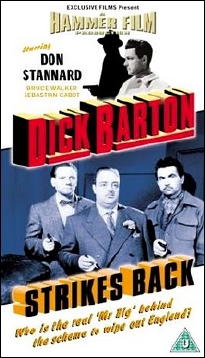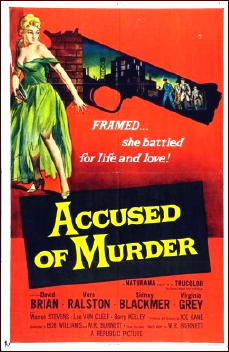November 2011
Monthly Archive
Thu 24 Nov 2011
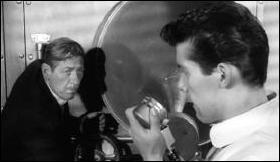
TIME LOCK. British Lion/Romulus, UK, 1957. Robert Beatty, Lee Patterson, Betty McDowall, Vincent Winter, Robert Ayres, Alan Gifford, Larry Cross, Sandra Francis, Sean Connery. Based on a play by Arthur Hailey. Director: Gerald Thomas.
While this is a small scale British thriller, and filmed there, the story itself takes place in Canada, as a small boy gets trapped in a bank vault right at closing time on Friday. The lock on the vault is timed so that it cannot be opened until Monday morning.
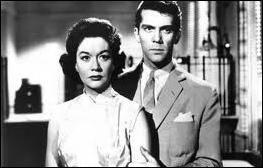
And that’s it. That’s all there is. The boy’s parents are there, as well as a couple of bank personnel, soon joined by more bank people, a police inspector, a radio news reporter, various doctors, and a supply of workmen with hammers and sledges (including Sean Connery, in what I’m informed was his first film speaking role).
All very professional, all quite concerned and even more competent. The mother goes into near hysterics at one point, but she’s quickly quieted, allowing the men on the job to do their job.
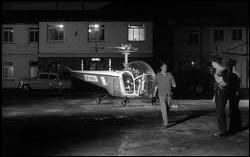
No side plots, no background on any of the people involved, and not a lot in the way of suspense either, even though that’s the category I put this film in.
If that last sentence sounds a bit snarky, well, maybe, but it is interesting to see how good men can figure out a good puzzle that’s presented to them, and then doing a good job in carrying out their ideas. On the other hand, if Sean Connery didn’t happen to have been in it, or if he’d never played James Bond, no one would have ever heard of this film.
Thu 24 Nov 2011
Posted by Steve under
Reviews[5] Comments
FRANK KANE – A Real Gone Guy. Dell D226, paperback reprint, May 1958; reprinted: 1966 [#7267]. Original hardcover edition: Rinehart & Co., 1956.
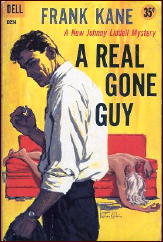
This is an experiment of sorts. I’m going to quote all of page one. It’s lengthy, but I think it’s worth doing. What direction do you think the story is going to go from here?
The Hotel Seymour was a dingy-fronted narrow stone building that nestled anonymously in a row of similarly dingy, narrow stone buildings ranging between Seventh and Eighth Avenues in the low Thirties. The two men pushed through the revolving door, crossed the napless knobby rug to the elevators in the rear. Neither spoke, neither paid any attention to the man behind the registration desk.
They walked to the back of the cage, stared at the back of the elevator boy who was preoccupied with the absorbing task of digging a black crescent of the nail of his index finger with a toothpick.
“Take us up,” the younger of the two men grunted. He was thick shouldered, heavy in the face. His fedora was pulled low over his eyes, its brim almost touching the top of his eyebrows. His companion was older, slight. He wore a baggy blue suit, a battered fedora pushed to the back of his head.
The elevator operator pulled his eyes up from his nails languidly, prepared to argue. Upon seeing the man, he decided against it. He looked for support to where the starter leaned against the glass counter of the cigar stand in a perennially unsuccessful make the blonde who presided over it. The starter had his back turned.
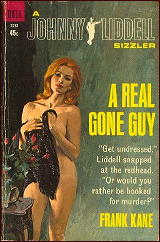
“You don’t hear so good. I said take us up,” the big man growled.
The operator licked at his lips, slammed the gates and pushed down the handle. “What floor?”
What comes next? That’s exactly what you’ll be tested on in a minute. In the meantime, I’ll continue talking while you think about it. This is a Johnny Liddell private eye story, as most of Kane’s mystery novels were, and it’s the real goods.
Here are some of the blurbs quoted inside the front cover, and all of them are true:
“If you like ’em tough, here’s your dish.”
“A racy, dangerous puzzler.”
“Never slackens its pace.”
“A tough, lively story by an expert writer.”
“Plenty of action in this hard-boiled, lurid story.”
Back to page one. The two guys are cops — did you guess? — on their way up to what turns out to be a fatal shoot-out with a guy who starts firing first, and one of the policemen also ends up dead.
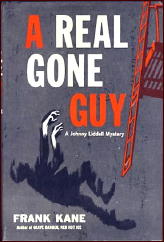
And here’s the next twist. Liddell is hired to prove that the guy in the room was murdered, which doesn’t get him in good graces with the police department, no matter how good his connections are. His client is a woman who he knows only from her voice on the phone, not to mention the $200 retainer.
There is also a good-looking nightclub singer involved, as well as lots of gangsters and bodyguards and women down on their luck, having pushed it too far. There is a smart-talking newspaper reporter lady named Muggsy, who gives Liddell an alibi when he needs one, at the sacrifice of her honor.
Which is about as lurid as it gets, when it comes down to it, but it takes some brainwork as well a brawn to solve the puzzle, which Liddell very smartly does, as soon as the page count starts working its way up to 192. (Which is, of course, all there are.)
Not a book to be long remembered in the annals of mystery fiction, but it got me through a flight from Hartford to Chicago, and it pleasured me the entire way. And in just in case you were wondering, everyone smokes up a storm, with lots of fingernails flicking tiny bits of tobacco off of tongues, but nary a brand name in the lot, not even a Lucky.
Wed 23 Nov 2011
Posted by Steve under
General[11] Comments
And it’s one to be reckoned with, I reckon.
Long time readers of the one you’re reading right now will recognize the name of Curt Evans, whose posts on this blog have revealed him to everyone as a deeply devoted fan (and ace historian) of the Golden Age of Detection.
He’s just started up his own blog, one called The Passing Tramp, and his first post is here.
Why “The Passing Tramp”? From that very first post, Curt explains:
“Ah, the passing tramp! That convenient figure in Golden Age English country house mystery on whom the posh people try to pin the murder of their despised weekend host (the one they themselves all had quite excellent motives for killing). Who could have slipped in through the French windows and clobbered Sir Humphrey Overr-Baring with that bust of Wellington? Why, it must have been a passing tramp, of course!”
Of course! But did you know that there was a “passing tramp” who became one of the era’s unlikeliest series detectives? Follow the link above to read more.
Mon 21 Nov 2011
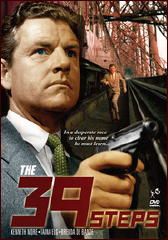
THE 39 STEPS. J. Arthur Rank, 1959. Kenneth More (Richard Hannay), Taina Elg, Brenda De Banzie, Barry Jones, Reginald Beckwith, Faith Brook, Michael Goodliffe, James Hayter, Joan Hickson, Sid James. Based on the book by James Buchan. Director: Ralph Thomas.
Based on the book, naturally, just as it says, but if truth be told, this version of the several films made of Buchan’s novel follows the Hitchcock version of 1935, the one with Robert Donat, more than the original text. Not that there’s anything wrong with that, of course!
So, how does it compare to the 1935 version? Can it possibly be better? It’s in color, which is somewhat of a plus, and even though the Scottish highlands are beautiful in color, there’s something to be said about the edge you get when you see them in black and white.
Kenneth More in this later film is more than up to the role, but he’s still no Robert Donat. As for Finnish actress Taina Elg, she was also a ballet dancer, and her legs are certainly up the role – which leads us straight to one of the better scenes of the movie, if you were to ask me.
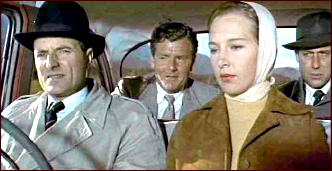
The story: When a woman he knows to be a spy is killed in Hannay’s apartment, and knowing time is of the essence in terms of the undercover plot she was working on, and based on what he has learned and knowing that waiting for the police to sort things out will take too long , he decides to bolt and make his way to Scotland – with half of Scotland Yard hot on his trail, or so it seems.
Whereby he connects up with the totally innocent Taina Elg (Fisher), first once on a train, then again later, whether she likes it or not, and of course she doesn’t, although she has no choice in the matter.
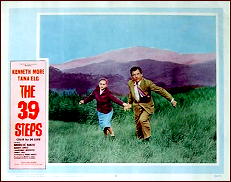
Hannay also meets, in pasing, several well-known British character actors, which probably helped to make this movie very popular in England at the time. It’s now many years later, however, and if you — like me — are a long way from the British Isles, the cast may be mostly incidental.
All in all, this is an enjoyable diversion, but in its running time of barely 90 minutes (the same as the 1935 version) the story seems rushed and out of breath for most of its time on the screen. It’s one of those cases, I suppose, where the reviewer ends by saying, “Your mileage may vary.â€
THE 39 STEPS. Made for British TV movie: BBC, 28 December 2008. Rupert Penry-Jones (Richard Hannay), Lydia Leonard, David Haig, Patrick Malahide, Patrick Kennedy, Hellory Sinclair, Eddie Marsan. Screenplay: Lizzie Mickery, based on the novel by John Buchan. Director: James Hawes.

This more recent version of Buchan’s book follows the novel more closely than Hitchcock did, and consequently, more than the film with Kenneth More. (See above.) Of course there has to be a romantic interest in any adaptation of the book – doesn’t there? – and so there is in this one as well.
Which makes the gender of the screenwriter important, or so it seems. The girl, or rather the very capable woman Richard Hannay meets in this BBC production is a suffragette, a grand champion for the right of women to vote in this dramatic adventure taking place in Britain in the dark days before World War I. It’s all about German spies, German sympathizers, a coded notebook and (eventually) a reference to the mysterious thirty-nine steps.
The novel, once again, rather than Hitchcock’s version is therefore the model, but only the model. (There is a scene, however, in which Hannay is fired upon by a wonderfully antique cropduster biplane while he’s being chased against the Scottish countryside, just to remind the viewer, that the master director was not entirely forgotten.)

But twist follows upon delightful twist, so much so that I guarantee you that your head will be spinning by the time you get to the end of the film. Delightful, I repeat, and I mean it (most TV critics did not think highly of it at the time, and that’s an understatement), but in retrospect there’s at least one and a half twists too many. I fear that if I were to watch it again (and I may) the story line would not make any sense at all.
Most of the cast will be unfamiliar to audiences in the US, so again there are no distractions there. Hannay is played by Rupert Penry-Jones, previously the star of the British TV espionage thriller MI-5. He was also said to be in the running to play James Bond at one time , but while he’s very definitely athletic and handsome, he doesn’t seem to have the magnetism and screen presence of, say, a Daniel Craig.
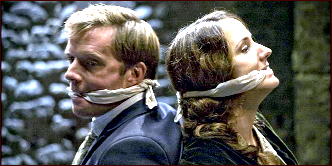
The other of the two leading characters constantly paired off with each other throughout the movie, the very capable Victoria Sinclair (I know, I’m repeating myself), well played by Lydia Leonard, a relative unknown, is often … let’s say extremely efficient and effective and say no more.
There is a scene, by the way, in which the pair are handcuffed together – no surprise there? – but its significance is cut short, alas, by a resolution that comes far too quickly, while the ending asks more questions than are answered, but to my mind, there’s nothing wrong with that.
Trailer: 1935 version (poor sound).
Trailer: 1959 version.
Video clips: 2008 version.
Sat 19 Nov 2011
REVIEWED BY DAN STUMPF:
DICK BARTON STRIKES BACK. Hammer Films, UK, 1949. Don Stannard, Sebastian Cabot, Jean Lodge, James Raglan, Bruce Walker, Humphrey Kent. Director: Godfrey Grayson.
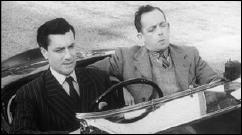
On the same enjoyably juvenile level as the pair of adventure serials reviewed here a while back, there’s Dick Barton Strikes Back, starring square jawed Don Stannard as square-jawed Dick Barton, world famous secret agent.
This is a little kid’s idea of a Spy Movie, with transparent trickery, obvious “surprise” villains and character development just below the level of a CLUE game, but it was clearly also the precursor of the James Bond films, with the suave, hard-fighting hero flung in and out of the clutches of sinister villains and predatory females with equal aplomb.
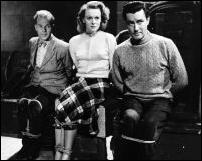
It’s a time-waster, sure, but a fun thing, with death rays, a sinister carnival and a really gripping final set-to up and down a (rather unsettlingly phallic) tower.
There’s also Sebastian Cabot, unrecognizable sans his beard, sporting a slimy moustache and the definitive Gloating Laugh: a rich, hammy, belly-jiggling, touch-of-madness cascade of sound that usually follows lines like, “Unfortunately, you vill not liff to vitness our triumph. Mwah-hu-huh-haaahh!”
Delivering a laugh like that with a straight face is generally beyond actors of his calibre, but Cabot enters into the spirit of the thing with a childish glee I found infectious.
Sat 19 Nov 2011
Posted by Steve under
Reviews[2] Comments
IT IS PURELY MY OPINION
Reviews by L. J. Roberts
TARQUIN HALL – The Case of the Missing Servant. Simon & Schuster, hardcover, June 2009; trade paperback, April 2010.
Genre: Private Investigator. Leading character: Vish Puri; 1st in series. Setting: India.
First Sentence: Vish Puri, founder and managing director of Most Private Investigators Ltd., sat alone in a room in a guesthouse in Defence Colony, South Delhi, devouring a dozen green chili pakoras* from a greasy takeout box.

Private Investigator Vish Puri has his hands full. An honest and respected public litigator has been accused of murdering his maidservant. The police say they have witnesses of him dumping the body. Puri must prove the man’s innocence and find the real killer.
A second case has Puri investigating a potential bridegroom. The bride’s father is certain there is something his daughter’s fiancée is hiding. And who attempted to kill Puri while he was on his own rooftop?
Puri is often compared by others to Sherlock Holmes but he also reminds me of Hercule Poiroit, albeit with a larger spirit. He also made me think, a bit, of Louise Penny’s Insp. Gamache because of his four rules of detection. All together, he is a very likable, appealing character. He’s not perfect, fortunately, as he has an intense fear of flying.
Puri is supported by a fascinating team of operatives, each with their own background. Best of all is Mummy, his mother, who conducts her own investigation and has the experience for so doing. No amateurs here.
It is fascinating to look at an entirely different culture. One forgets how old a civilization is India yet it a culture in transition. There is a bit of a moral and/or cautionary tale for Westerners here. The gap between the wealthy and the poor is huge. The old jobs for the individual and the poor are disappearing. The Indian court and justice system is a shamble. Bribery is the way in which much gets done. “How can India reach superpower status with all the corruption around.â€
Yet Puri also observes that Krishna stated “The discharge of one’s moral duty supersedes all other pursuits, whether spiritual or material.â€.
The three mysteries within the story are very well done. There is nothing obvious about them and the investigation is done through following the clues and investigative procedure, which I like, and the writing is first rate.
This was a very enjoyable book and one I probably would not have picked up had it not been a selection of my mystery readers’ group. I definitely recommend The Case of the Missing Servant and I plan to read more in the series.
Rating: Very Good.
Editorial Comment: Number two in the series is The Case of the Man Who Died Laughing (2010).
Fri 18 Nov 2011
Posted by Steve under
Reviews[8] Comments
A Review by MIKE TOONEY:
THE BEST OF ELLERY QUEEN: Four Decades of Stories from the Mystery Masters – Francis M. Nevins, Jr., and Martin Greenberg, Editors. Beaufort Books, hardcover, 1985.
Here’s a fine collection of fifteen short stories by Ellery Queen that truly are representative of the two cousins’ output from 1933 to 1967. On occasion some of these stories possess the plot complexity of most of the novels, but usually they keep it simple — simple, but not necessarily easy! (Indeed, how much ready knowledge do YOU have of Roman mythology, philately, Lewis Carroll, spoonerisms, American history, and wedding anniversary lore?)
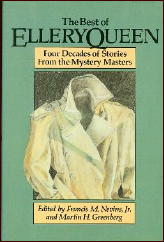
In his introduction Francis M. Nevins, Jr. is aware of how most Golden Age of Detection fans who have read Ellery Queen are familiar with the Philo Vance clone that was the early Ellery and the later, more socially involved Ellery. However, Nevins goes on to delineate four distinct phases in the career of our master sleuth, each one greatly influenced by market considerations and personal events in the lives of the two cousins who were “Ellery Queen”:
â— Ellery I (1929-1935): The Van Dine-ian character “detached from the terrible events around him” and, in Manfred Lee’s later, rueful assessment, “the biggest prig that ever came down the pike.” But, oh, those problems! “On a smaller scale,” writes Nevins, “the best of their Period One short stories are like their early novels: richly plotted specimens of the Golden Age deduction puzzle, bursting with bizarre circumstances, conflicting testimony, enigmatic clues (including that uniquely Queenian device, the dying message), alternative solutions, fireworks displays of virtuoso reasoning, and a crackle of intellectual excitement.”
â— Ellery II (1936-1940): The Maestro “gradually loses his priggishness and becomes more human. Compared with the Period One classics, much of the cousins’ output of the late 1930s suffers from intellectual thinness, a surfeit of so-called love interest (meaning tedious boy-meets-girl byplay), and characters tailored to please story editors at the slick magazine suites and the studios. But in the longer view,” says Nevins, “they managed at least in part to open up the deductive puzzle and make room within its cerebral rigor for more of the virtues of mainstream storytelling.”
â— Ellery III (1941-1958): Fred Dannay, “the historian and bibliophile of the partnership”, founded EQMM, and he and Manny Lee “inaugurated their third and richest period as writers … which embraced twelve Queen novels and two short-story collections”; “the cousins fused complex deductive puzzles with in-depth characterization, finely detailed evocations of place and mood, occasional ventures into a topsy-turvy Alice in Wonderland other world, and explorations into history, psychiatry and religion.”
â— Ellery IV (1959-the end): “After five years of almost complete fictional inactivity, a fourth period opened with The Player on the Other Side (1963). These late Queens are marked by a zest for experiment within the strict deductive tradition and a retreat from all semblance of plausibility into what Fred liked to call ‘Fun and Games,’ i.e., a potpourri of stylized plots and characters and dozens of motifs recycled from earlier Queen material.”
Nevins’ introduction is admirably concise and informative, touching on the triumphs and tragedies the two cousins experienced in a long, productive, and illustrious career.
The Stories:
1. “The Glass-Domed Clock” (First Appearance: Mystery League, October 1933).
Where: New York City. When: March 7, 1926. Problem: Martin Orr, “the celebrated little Fifth Avenue curio dealer whose establishment was a treasure-house of authentic rarities,” has been brutally murdered. He evidently leaves behind an element that Ellery Queen often returned to, the dying clue: In one hand he is clutching a birthstone, with a broken antique clock lying beside his body. Suspects: At least seven likely ones.
Motive: Inspector Queen says, “This is a grudge kill, son”, but is it? — It was “a problem in which such components as the following figured: a pure purple amethyst, a somewhat bedraggled expatriate from Czarist Russia, a silver loving-cup, a poker game, five birthday encomiums, and of course that peculiarly ugly relic of early Americana catalogued as ‘the glass-domed clock’ — among others!”
The murderer makes several mistakes in (1) overthinking the crime, (2) assuming others know as much as s/he does, and (3) not reckoning on the formidable intellectual powers of Ellery Queen (who, by the way, needs fully one third of the story — six pages — to explain his chain of reasoning).
2. “The Bearded Lady” (First Appearance: Mystery, August 1934, as “The Sinister Beard”)
Where: Long Island, New York. When: Unspecified. Problem: A doctor, Terence Arlen, due to inherit one hundred thousand dollars from a recently changed will, is found stabbed to death with a Florentine stiletto. As an amateur artist, he could be expected to have an easel nearby — but why does his copy of a Rembrandt masterpiece feature a Dutch housewife with a beard?
Suspects: A mansion full of people, none of them with alibis. Motive: We are talking about a fortune in inheritance, right? — The murderer takes modesty to new extremes. Here is Ellery on how he perceives himself: “… he was also a detective — an appellation he cordially detested.” Ellery on his own limitations: “I don’t go about pulling murderers out of my hat.” And Ellery on life in general: “The world’s all right; the trouble is the people in it.”
3. “The Mad Tea-Party” (First Appearance: Redbook, October 1934. Filmed for TV in 1975 with Jim Hutton as Ellery, David Wayne as Inspector Queen, Tom Reese as Sergeant Velie, and an all-star cast as the victim and various suspects.)
Where: Long Island, New York. When: Unspecified. Problem: Richard Owen, Wall Street maven and peccant husband, goes missing shortly after a dress rehearsal of a play. In order to solve the mystery of his disappearance, Ellery must resort to psychological subterfuge — once he has resolved the conundrum of the disappearing wall clock.
Suspects: A white-haired old lady, the house staff, the March Hare, the Dormouse, a BIG girl named Alice, and a nine-year-old spoiled brat. Motive: About as ancient as they come. — Golden Age aficionados who have seen the TV version may remember the name changes of the characters to the surnames of Golden Age authors of the ’20s and ’30s (Doyle, Allingham, etc.). They may also recall how closely the script hewed to this story and that “The Mad Tea-Party” was the only original EQ work adapted for the Jim Hutton series.
4. “Man Bites Dog” (First Appearance: Blue Book, June 1939)
Where: New York City, the Polo Grounds. When: During the seventh game of the World Series.Problem: Big Bill Tree, one-time baseball great, collapses during the game. The doctor determines he has been poisoned orally by ingesting prussic acid — but how: in his hot dog as everyone assumes, or was there some other means?
Determining HOW, as Ellery knows, will lead straight to the WHO. Paula Paris’s problem is much more difficult: getting Ellery involved in the case, because as a rabid baseball fanatic he refuses at first to give it any attention at all.
Suspects: Fifty thousand of them, plus the Yankees’ bench players and a kid from the Bronx who’s an autograph hound. Motive: That old reliable standby, jealousy, mixed with contempt. (Note: Official records show that the only time the Giants and the Yankees played more than six World Series games was in 1921 — eight outings — when both cousins were about sixteen.)
5. “Mind Over Matter” (First Appearance: Blue Book, October 1939)
Where: New York City, the Stadium. When: Unspecified. Problem: Mike Brown, the former heavyweight boxing champion, is found murdered in the back seat of a roadster shortly after losing the title. Since he’s been stabbed ten times, Ellery’s comment seems apt: “Someone’s used him for a pin-cushion.” But there’s also that little matter of Ellery’s missing coat….
Suspects: Thirteen men, several managers, and one curvaceous ex-wife. Motive: Money, fame, respect, ego commingled. — Another case wrapped up on the spot. With today’s DNA forensics, the murderer would have been nailed eventually, but Ellery tends to work a lot faster on average.
6. “The Inner Circle” (First Appearance: EQMM, January 1947)
Where: New York City and Scarsdale. When: The week after Christmas 1946 (year inferred). Problem: The members of the Inner Circle of the Januarians Alumni Club (a tontine) are dropping like flies and one of the survivors suspects murder. Shortly after hiring Ellery to investigate, however, “he himself is found lying in a gully with four thousand pounds of used car on top of him.”
Suspects: Three. Motive: “$200,000 worth of negotiable securities.” — Eventually Ellery finds “the college denominator” that solves the case, using the POE (Process of Elimination) method.
7. “The Dauphin’s Doll” (First Appearance: EQMM, December 1948)
Where: New York City, the Queens’ apartment, and Nash’s Department Store. When: December 23-25, 1947 (year inferred). Problem: A huge collection of dolls — including one with an expensive stone set in it — are to be displayed in a bustling department store on Christmas Eve.
All well and good, but a master thief calling himself Comus vows that he will steal the valuable doll regardless of how much protection Inspector Queen, Sergeant Velie (incognito as Santa Claus, no less), the entire NYPD, Nikki Porter, and the Inspector’s brilliant son can offer. Suspects: Anyone entering Nash’s Department Store on the day before Christmas.
Motive: A blue diamond, 49 carats, worth over $100,000. — Ellery’s philosophical tidbit: “A good trick, like a good woman, is best in the dark.” As the author(s) tell us, a clue to the solution of this crime can be found on page 262b of Volume 6 of the 175th edition of the Encyclopedia Britannica.
8. “The Three Widows” (First Appearance: This Week, January 29, 1950, as “Murder Without Clues”)
Where: New York, Murray Hill. When: Unspecified. Problem: Mrs. Hood, a rich old widow, has two step-daughters who will inherit a sizeable fortune upon her demise. Two attempts on her life fail, but a third succeeds. At first, Ellery is sure it’s suicide — at first….
Suspects: Four — the two women, a doctor, and, of course, a lawyer. Motive: One million dollars to each step-daughter. — The lawyer tells Ellery that this problem is “more your sort of thing than the police’s”; to which Ellery replies, “Well, my sort of thing is always simple, provided you see it.”
9. “Snowball in July” (First Appearance: This Week, August 31, 1952, as “The Phantom Train”)
Where: Manhattan and upstate New York. When: Unspecified. Problem: A jewel robber’s moll gets jilted and takes it on the lam to the Great White North; she knows too much about him, and he knows she knows. Inspector Queen and Ellery devise a scheme to get her back into the country aboard a diversionary train. Everything is going according to plan — until the train she’s on vanishes off the face of the earth….
Suspects: Diamond Jim Grady and his merry men. Motive: The prospect of frying in the electric chair typically lacks appeal. — The problem of making hundred-ton trains disappear has entertained minds at least since A. C. Doyle.
10. “My Queer Dean!” (First Appearance: This Week, March 8, 1953)
Where: “a New York university”. When: Unspecified. Problem: The Baconian Hypothesis has generated controversy and, probably, a modicum of ill will over the years; but one wonders how often it has led to felonious assault and robbery.
One of Ellery’s old Harvard profs reveals that an Englishman has a book for sale that disproves the Hypothesis, and that he’s willing to pay for it with his life’s savings. Unfortunately, he innocently makes this revelation in public before people with itching ears….
Suspects: Three professors and a shady book dealer. Motive: A potentially priceless text and/or ten thousand dollars in cash. — For solving this one, Ellery deserves a twenty-one sun galoot.
11. “GI Story” (First Appearance: EQMM, August 1954)
Where: Wrightsville in upstate New York. When: Wintertime. Problem: Clint Fosdick, a local businessman, is found murdered in his library: poison in the gin. On a notepad he has left a dying clue: the letters “GI,” which presumably point to his killer.
Chief Dakin is absolutely certain he knows who did it, but for Ellery what seems obvious to the chief isn’t to him; and what IS obvious, the dying message, is plain for anyone to see and understand.
Suspects: Three stepsons of variable character and one housekeeper. Motive: The dead man leaves behind an unspecified fortune.
12. “Miracles Do Happen” (First Appearance: EQMM, July 1957)
Where: New York. When: The 1950s (inferred). Problem: A loan shark named Tully is found stabbed to death in his dingy office. Certainly almost no one will be weeping at his funeral; but several people are in the vicinity who not only have motives but also the opportunity to hasten his departure, among them a decent family man with his back literally to the wall.
Suspects: Four. Motive: Money — and love. Concerning Ellery’s ability to pull metaphorical rabbits out of metaphorical hats, Sergeant Velie says to no one in particular: “And the beauty of it is, he does it all with his little sleeves rolled up,” which earns him a withering glance from Inspector Queen.
13. “Last Man to Die” (First Appearance: This Week, November 3, 1963)
Where: The Queens’ apartment and the Butlers Club on Sixtieth. When: 1963. Problem: The last two surviving members of a tontine are found dead, each one in his own bed. They were known to dislike each other a lot, and it was this animosity that did them in; but did they kill each other, or was someone else involved?
And the time of death proves to be crucial, because whichever one died last will be posthumously bequeathing a fortune to his heir. Ellery’s solution is elegantly simple.
Suspects: Two octogenarian butlers, “the belle with the bell voice”, and a “playboy grandson.” Motive: “a brownstone and $3,000,000 worth of blue-chip securities besides.” — See “The Inner Circle” for another tontine story.
14. “Abraham Lincoln’s Clue” (First Appearance: MD, June 1965)
Where: Eulalia in upstate New York. When: Unspecified. Problem: Ellery must come to the aid of a damsel in (financial) distress. She and her improvident father owe a great deal; however, he claims to possess two rare — perhaps unique — items: a book with the signatures of both Abraham Lincoln and Edgar Allan Poe on the flyleaf AND a holographic letter written by Lincoln on the day he died.
Two collectors are willing to pay a considerable sum for them; but the owner expires, leaving behind an impenetrable clue as to where these collectibles might be — impenetrable to everyone but Ellery Queen, that is.
Here, by the way, is the Lincoln clue in its entirety: “The hiding-place of the book is in 30d, which”. Go ahead, you figure it out.
Suspects: Fanatical collectors aren’t always reliable, are they? Motive: The two items were bid up to sixty-five grand. — You don’t normally associate the Great Emancipator with the Raven, but Lincoln was known to be an admirer of Poe’s writing. This case calls for much cogitation and activity on Ellery’s part, prompting one character to remark: “I can’t decide whether that fellow is a genius or an escaped lunatic.” And neither can anybody else!
15. “Wedding Anniversary” (First Appearance: EQMM, September 1967)
Where: Wrightsville. When: Unspecified. Problem: Ernst Bauenfel, “the nearest thing to a civic saint that Wrightsville’s ever had,” is celebrating his first wedding anniversary with his gorgeous second wife when he collapses and dies, poison in his liqueur; but he is barely able to provide Ellery a dying clue in the form of an uncut diamond (he is a jeweler).
The diamond, of course, leads Ellery to the number thirty (isn’t it obvious?), and from there to five likely suspects, one of whom has managed to commit murder from the most disadvantageous position it’s possible to imagine….
Suspects: They include the managing editor of a newspaper, a general building contractor, a paperbox factory owner, and a voluptuous, newly-minted widow. Motive: Jealousy, although a fortune in inheritance could figure into it. As Ellery says: “I admit, motive in this case is the tough one.” — Beholding yet another murder victim at his feet, Ellery bitterly vows: “I swear I’ll never set foot in Wrightsville again.”
Thu 17 Nov 2011
ACCUSED OF MURDER. Republic Pictures, 1956. David Brian, Vera Ralston, Sidney Blackmer, Virginia Grey, Warren Stevens, Lee Van Cleef, Barry Kelley, Elisha Cook Jr. Screenplay by W. R. Burnett, based on his novel, Vanity Row. Director: Joseph Kane.
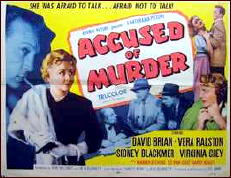
Time was starting to run out for Republic Pictures when this film was produced, and as it so happened, the end of Vera (Hruba) Ralston’s motion picture career was close to ending as well. Republic lasted until 1959, while Miss Ralston’s last appearance on film was in 1958. That their fortunes were so long tied together is due to one fact: she was the longtime protege of Republic Pictures studio head Herbert J. Yates, whose last year on top was also — you guessed it — 1958.
Her acting abilities, never regarded very highly, were probably adequate for most of the generally low budget films she was in, and over the years, there were 27 of them. In Accused of Murder she’s a night club singer who’s suspected of murdering a high-flying attorney (Sidney Blackmer) in debt to the mob, but luckily for her, the homicide lieutenant in charge of case (David Brian) finds himself falling in love with her, and he’s the only person standing between her and a life in prison.
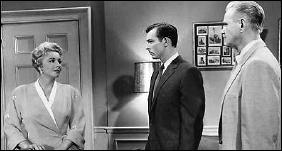
Definitely not believing her story is Brian’s second-in-command, a very young Lee Van Cleef, whose way of carrying himself reminded me a lot of Lee Marvin, lean and lanky and in so smooth control of himself.
There’s more to the story than this, including a scar-faced hit man (Warren Stevens) whom we see being paid for killing Blackmer, and a would-be blackmailer, a dime-a-dance girl (Virginia Grey) who saw Stevens at the scene of the crime. There are a few twists to the tale, some of them quite clever, or there would have been if we (the viewer) hadn’t been shown too much in the beginning, and yet not enough to stop us from puzzling over whatever it was that wasn’t shown. Speaking entirely for myself, you understand.
Adequate, therefore, but all around? Only adequate. There’s no other word that might apply, unless it was mediocre, and truthfully, Accused of Murder is a step above that. It’s a small step, but a step, nonetheless.
Thu 17 Nov 2011
Posted by Steve under
Reviews[3] Comments
Reviewed by RICHARD & KAREN LA PORTE:
JON L. BREEN – The Gathering Place. Walker, hardcover, 1984; paperback, 1986.
This murderous dive into the calm ambiance of Vermillion’s Bookshop has an other worldly aura. Rachel Hennings has inherited the bookshop after her Uncle Oscar died. Oscar Vermillion was the grand old man of the antiquarian book trade from his long established shop on Santa Monica Boulevard in West Los Angeles.
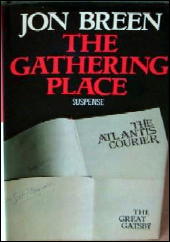
Rachel has a strong interest in old books and ESP. This extra-sensory perception takes the form of spirit writing in a unique form. She signs the names of dead writers in their books when she is in the shop, which was The Gathering Place for Fitzgerald, West, Faulkner, Huxley and the rest of the gems in that period’s literary diadem.
When the spirit hand puts the signature of a murdered, virtually unknown hack writer on the endpaper of an early novel by today’s exalted author of a record best seller, Arlen Kitchener, more than the spook hits the fan.
More bloody murder is done. Agents, authors, celebrities and all get tangled up in a mass of plots and counterplots. Did Kitchener use a ghost writer? Is Detective Manuel Gonzales going to make out with Rachel or, if not, which of the two Wellman brothers will?
Who killed the ghost writer Ransom Blaisdell and why? Is Rachel’s spirit writing a gift or grift? All these questions develop interlocking answers that lead to a whirlwind romantic finale.
The story with its dips into the white magic of spirit writing, arcane secrets in an ancient bookshop and high-hearted romance with warm witty people would make excellent material for a Disney feature film.
Jon L. Breen uses his local knowledge of the Los Angeles book scene with a fine sense of contemporary dialogue and a gleeful look into pedestrian minds trying to ride a hobby horse.
— Reprinted from The Poisoned Pen, Vol. 7, No. 1, Fall-Winter 1987.
Bibliographic Update: Rachel Hennings made a second (and final) appearance in Touch of the Past (Walker, 1988), in which she helps investigate the present day murder of a retired 1930s actor and book author.
Wed 16 Nov 2011
Posted by Steve under
Reviews[11] Comments
THE BACKWARD REVIEWER
William F. Deeck
R. C. WOODTHORPE – Death in a Little Town. Doubleday Crime, US, hardcover, 1935. First Edition: Ivor Nicholson & Watson, UK, hardcover, 1935.
A usually enjoyable subgenre of the crime story is the English village setting. This is one of the most delightful of them. Mr. Woodthorpe, in this and other novels, can be compared — but, since comparisons are odious, this reviewer won’t stoop to it — to Robert Barnard in one of his more mellow moods.
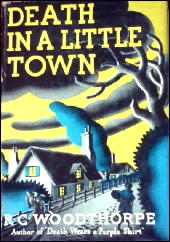
The most hated man in the town in murdered shortly after the villagers have torn down the fence he put across a public right-of-way. The murder is investigated by the local police sergeant, one Whalebone, who is himself an interesting and intelligent character, and by some anonymous individuals from Scotland Yard who deal mostly with paperwork.
In the novel we meet Miss Mathilda Perks, former schoolmistress, with a blunt tongue and a foul-mouthed and surprisingly bright parrot named Ramsey MacDonald; Miss Perks’ brother Robert, who has a tendency to disrobe on occasion wherever he might happen to be; Daphne Chrystal, a slattern who could give Gracie Allen some pointers in witless conversation; her husband, Walter, who suspects her of infidelity for reasons best known to himself…
More: Frank Thornhill, a former pupil of Miss Perks, who is of independent means and no particular ambition except maybe to set up a nudist colony; the Rev. William Chandos, whose biggest concerns are neutrality in all things and how to handle the various views in the village about public bathing on Sunday; and Michael Holt, about whom the police say:
“There’s nothing against him, except that he’s a writer of fiction. Quite a respectable person; doesn’t even write detective stories….”
A novel well worth trying to find by those inclined to enjoy the English village setting and somewhat eccentric characters. The humor, it should be added, is natural and unforced. The detection, however, does leave something to be desired.
— From The Poisoned Pen, Vol. 7, No. 1
(Whole #33), Fall-Winter 1987.
Bibliographic Update: Miss Mathilda Perks also appeared in The Shadow on the Downs (1935). Woodthorpe’s other series character, Nicholas Slade, also made two appearances, one of which, Death Wears a Purple Shirt, was also reviewed by Bill Deeck in that same issue of Poisoned Pen. It was posted here earlier on this blog.
« Previous Page — Next Page »














